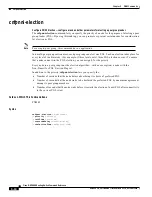
5-13
Cisco MGX 8850 Routing Switch Command Reference
Release 2.0, Part Number 78-10467-04 Rev C0, October 2001
Chapter 5
PNNI Commands
addpnni-summary-addr
Usage Guidelines
The PNNI summary address table information comes from the internal data base (IDB). If you change
or create a PNNI summary address, a topology state packet carries the information to the IDB. The
summary address table updates itself from the IDB.
node-index
The node index indicates the relative position of the logical node within a
multi-peer group on the switch. The range is 1–10, and the lowest level is 1. If you
do not have the node index, use dsppnni-node to see a list of all logical nodes and
node indexes on the current switch. In the current release, the value of node-index
must be ‘1’.
Range: 1–10
Default: 1
addressprefix
The summary address assigned to the node. The length of addressprefix is the
value of prefixlength.
As shown in
Figure 5-5
, addressprefix is a formatted hexadecimal string.
Default: The default is the first 13 bytes of the atm-addr.
prefixlength
Specify the length of the address-prefix in bits. The range is 1–152 bits. You
configure PNNI routing to look at a specific length in the address, so the length of
the PNNI summary address is also configurable. For example, if you configure a
node with an 88-bit PNNI summary address, that node sets up a call from any
addresses that matches the first 88 bits. The number of addresses that a PNNI
summary address can include is inversely related to the length of the PNNI
summary address—a shorter summary address can include more addresses than a
shorter prefix.
In the current release, the zero-length summary address is not supported.
Range: 1–152 bits
Default: none
-type
Specify the type of the PNNI summary address, either exterior or internal.
internal: The summary address includes only addresses that are within the peer
group.
exterior: The summary address includes addresses that are outside the peer group.
Default: internal
-suppress
Specify whether the summary address is advertised to other nodes
false: The summary address is advertised (is not suppressed).
true: The summary address is not advertised (is suppressed).
Default: false
















































